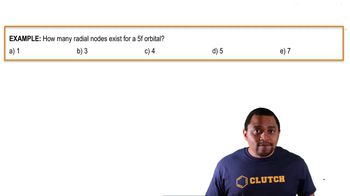Textbook Question
(c) What can you say about the average distance from the nucleus of an electron in a 2s orbital as compared with a 3s orbital?
677
views

 Verified step by step guidance
Verified step by step guidance



(c) What can you say about the average distance from the nucleus of an electron in a 2s orbital as compared with a 3s orbital?
(d) For the hydrogen atom, list the following orbitals in order of increasing energy (that is, most stable ones first): 4f, 6s, 3d, 1s, 2p.
(a) With reference to Figure 6.19, what is the relationship between the number of nodes in an s orbital and the value of the principal quantum number?
(d) For the hydrogen atom, list the following orbitals in order of increasing energy: 3s, 2s, 2p, 5s, 4d.
(a) For an He+ ion, do the 2s and 2p orbitals have the same energy? If not, which orbital has a lower energy?
(b) If we add one electron to form the He atom, would your answer to part (a) change?